We left Dublin in the morning and headed south to County Wicklow. Our destination that day was Glendalough, which would be one of my favorite stops on the trip.
This was taken from the bus window, showing some of the scenery we were driving through. The little white dots here are sheep.

Glendalough is an "Early Medieval monastic settlement founded in the 6th century by St Kevin, a hermit priest." The location here was sought after by St. Kelvin because of its remoteness, but the site grew in such popularity that it soon became one of the main religious universities in Ireland. It was sacked several times by Vikings, but began to decline after it was partially destroyed by English troops in 1398. Now, a collection of old ruins lays in the valley, nestled by the shores of two lakes. The buildings here are thought to have been built between the 8th and 12th centuries, and were restored in the 1870s.
Here is the view of the creek, with the ruins popping up in the distance.
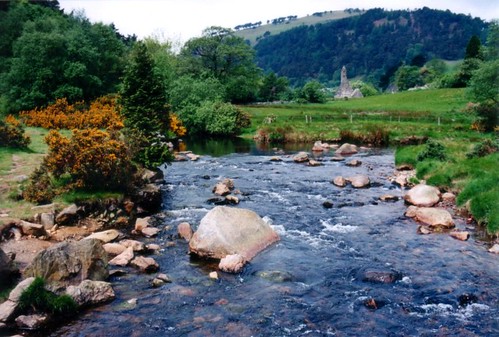
The name comes from the Irish Gleann Dá Loch, meaning "Glen of Two Lakes."
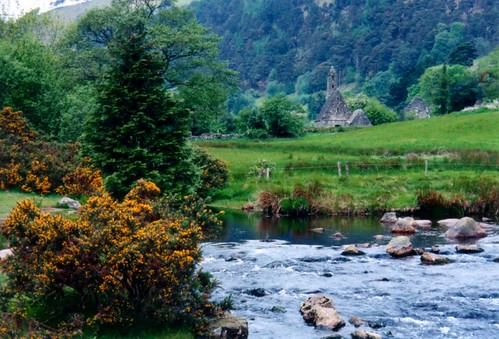
A closer view, with St. Kevin's Kitchen (built in the 11th century or earlier) and the round tower.
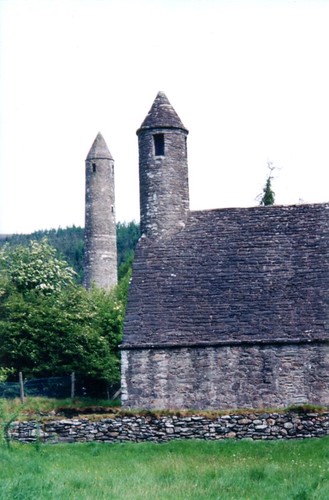
St. Kevin's Kitchen is actually an old church, but the belfry here looks like a chimney and it was nicknamed as the kitchen.
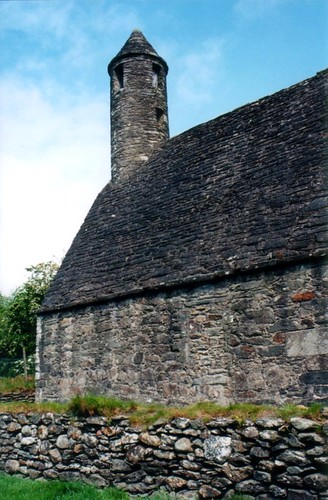
And a view of some old steps leading up towards the round tower. There are several towers like this across Ireland, and this one has been called one of the finest in the country. It was thought the round towers served as a defensive measure. A lookout would sit at the top of the tower and warn of any invading attackers (like the Vikings). Then all the valuables nearby would be stashed in the tower, with the ladder to the door pulled away (the door sat way above ground). That theory has been questioned, and the new explanation was that these towers were built as a belltower.
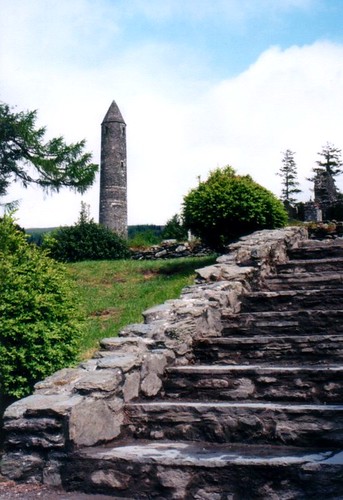
The cemetery at Glendalough is situated with a scenic view over the valley.
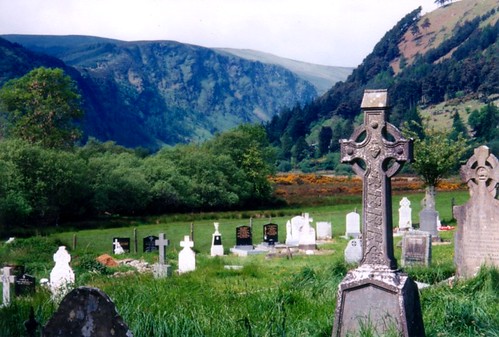
The ruins sit near the edge of two sparkling lakes. With some free time to explore the area, we had two options - look around the visitor center, or take the path that went deep into the thick forest by the lakes. Of course I chose to take the walk, along with only one other person from our group.
Ireland is quite famous for its rain, and it had been lightly drizzling just about every day we were out there. The weather was nice this day and decided to wait until we were walking way out in the woods before it sent down buckets of rain. We were quickly soaked, along with scores of other people caught out along the trail. We all stood under some trees, trying to get some shelter from the storm. We were next to a group of Irish school kids, who were running around. Two girls walked by us and let out a polite “hello” in a neat little Irish accent. Me and the other Arkansas student responded with a “Hi,” which with our southern accents seemed to stretch out into something like “hiiiiiiiiiiii.” They both looked at us oddly, and one of them asked where were from. “No!” The other yelled, “can we guess?” “Um, ok sure.” So we stood there while they tried to determine the location of our wacky accent. “South Africa?” said the first girl. Her friend turned to her with a dumbfounded look. “South Africa? You idiot that’s an American accent!” We told her she was right, and they ran off.
This is the view of one of the lakes, during the heavy downpour.

The storm didn’t stick around long, and the views along the lakes were great in the clearing weather. Sorry these pictures aren’t great quality, they’re old scans of 10 year old prints. This is the same lake, after the storm cleared:

After the rain stopped, the forest along the trail took on an even more beautiful shade of green. The trees there lived with a certain sense of history, and it was amazing to think of how many people have followed this trail throughout the centuries. This small path took off from the main trail, heading off into the woods. This is one of my favorite shots from the trip:
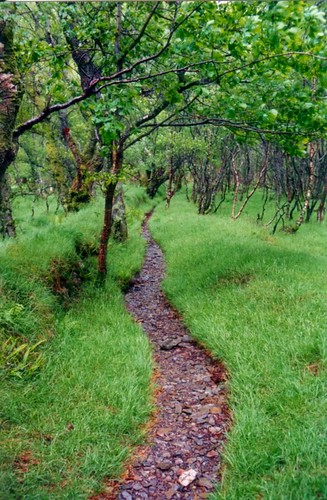
I like to think that this path was built by a Saint, and has been in use for centuries. Of course it probably leads to something like a maintenance shed, but we didn't have time to see where it went.
We were drenched when we made it back to the visitor center, but we had taken too long on the trail and the rest of our group was waiting for us at the bus. I stopped to get one last shot of Glendalough:
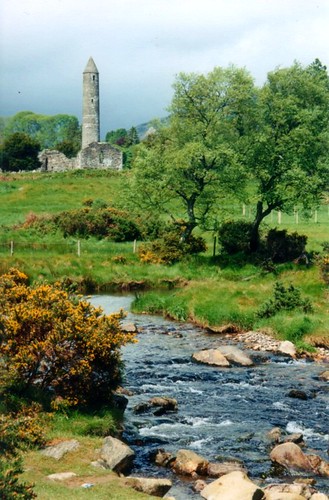
On the way out we stopped at this place called “The Meeting of the Waters,” and ate at a little pub perched right at the spot where the rivers Avonmore and Avonbeg converge to form the River Avoca. It was nice enough spot, and is where the Irish poet Thomas Moore composed a poem called “the meeting of the waters.” Here is the poem:
THERE is not in the wide world a valley so sweet
As that vale in whose bosom the bright waters meet;
Oh! the last rays of feeling and life must depart,
Ere the bloom of that valley shall fade from my heart.
Yet it was not that nature had shed o’er the scene
Her purest of crystal and brightest of green;
’Twas not her soft magic of streamlet or hill,
Oh! no—it was something more exquisite still.
’Twas that friends, the beloved of my bosom, were near,
Who made every dear scene of enchantment more dear,
And who felt how the best charms of nature improve,
When we see them reflected from looks that we love.
Sweet vale of Avoca! how calm could I rest
In thy bosom of shade, with the friends I love best,
Where the storms that we feel in this cold world should cease,
And our hearts, like thy waters, be mingled in peace.
It's a nice poem, and awesome that he mentioned the word "bosom" a lot in it. This is the view from the Meeting of the Waters, of the River Avonbeg flowing under a bridge just before it meets the other waters.
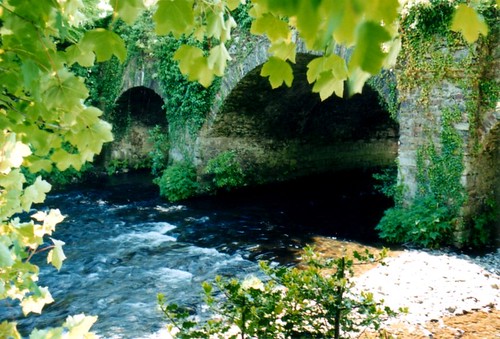
We stayed with host families all but two nights while we were in Ireland. This night we got to stay in a fancy hotel that was also a castle - Kinnity Castle, near the town of Birr. We were supposed to have a lot more time to stay there, but our delay in reaching Ireland ate up the time that could have been spent horseback riding, hiking or sitting at the castle bar. We got there in the evening, and nearly just had enough time to check into our rooms (which were huge – the bed in my room was probably the size of the entire bedroom at our host family’s place in Dublin). We were treated to a fine dinner that night – I had something with salmon in it. And then we retreated to the comforts of the bar, and I don’t remember much else of the night after that. Part of that night came back to haunt me when I got home though. I ended up drunk dialing my brother, who was in law school in Fayetteville at the time. I left an embarrassingly intoxicated message on his answering machine, which he was all too happy to replay to the family and all his friends. He still has it, and will gladly play it on request.
Tuesday, May 25, 1999:
It was rough the next morning, along with the hangover I was also catching a cold. To help clear the cobwebs from my head, I took a nice walk around the castle. It was located next to a creek, that was surrounded by a thick forest. It did just about look like someplace you would expect a leprechaun to jump out of it. I walked by this old bridge, which unfortunately was gated shut:
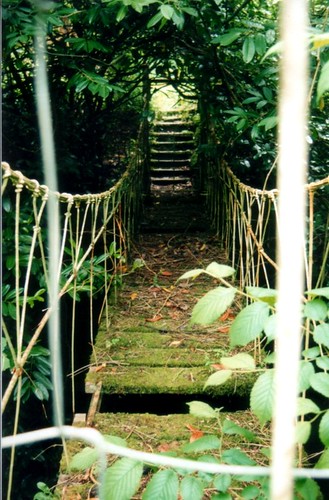
This is the front of the Kinnity Castle:
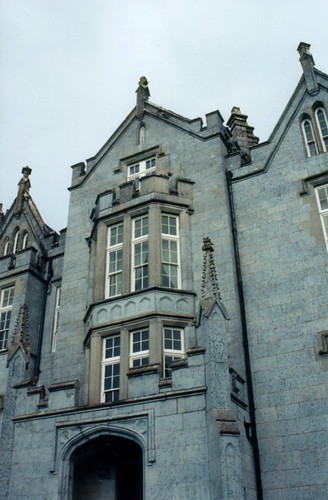
And a wide shot of the castle. To the far right of the shot you can see the tour bus that took us across Ireland.

Before I get any farther I want to mention our bus driver. He was extremely patient, and didn't seem to mind driving around a bunch of wacky Americans. But right above the driver's seat in the bus was a huge bottle of whiskey. We noticed that the amount of whiskey in the bottle got lower and lower each day of the trip. He was a nice enough guy, I talked to him a few times about photography. He said that he would go out of his way to show some cool spots that would make for some neat pictures - thanks!
And back to the story - my head was still a bit stuffy, so on the bus I took some cold medicine that one of my friends let me have. It was strong stuff, and it made me loopy. I don’t remember much of our stop in Limerick, or the tour of the castle.
This is the view outside of King John's Castle, with the tower of St. Mary's Cathedral looming overhead.

And a shot taken during the tour, from inside the castle. King John's Castle was founded sometime around 1200.
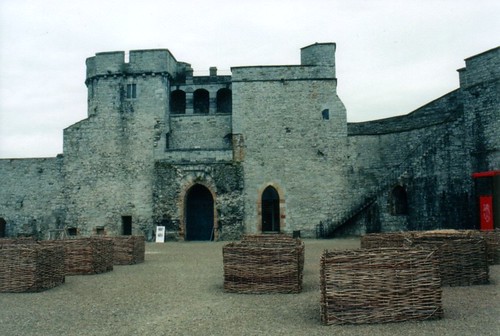
I do remember being in the castle gift shop looking at some cheesy postcards, thinking that they were the most hilarious things in the world. I would take them off the rack and go and show them to people, giggling the entire time. Then, quite suddenly, the medicine wore off and I sobered up out of the loony state. I embarrassingly put the post cards back on the rack.
This is the view of the River Shannon, flowing past the castle and Limerick.

We drove on to our next destination, the city of Tralee along the western coast of Ireland. We met up with a new host family, who were disappointed with our choice of evening activities. We had plans (or well the professors made the plans), to attend a local play that night. The host family thought that we would have a much better time at the pub with them watching the big soccer game that night (Manchester United vs. some team I can't remember now). We didn’t really have a choice, sadly, we still hadn’t gotten our final grades for the class. The host family was absolutely correct though. The play was all in Gaelic, so none of us understood a single word that was spoken. I'm sure that the play had fine performances by gifted actors and had outstanding theatrical production. But it was hard to follow what was going on since none of us understood Gaelic. I ended up sleeping through most of it. The football game would have been a lot more fun.
In Part 3, a tour of the Dingle Peninsula, one of the most beautiful places in Ireland.


No comments:
Post a Comment